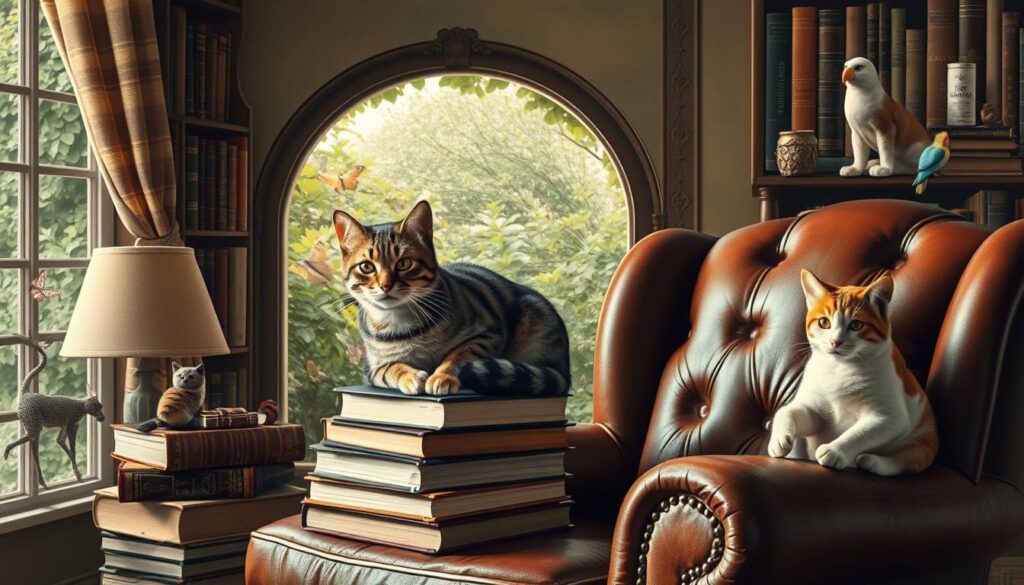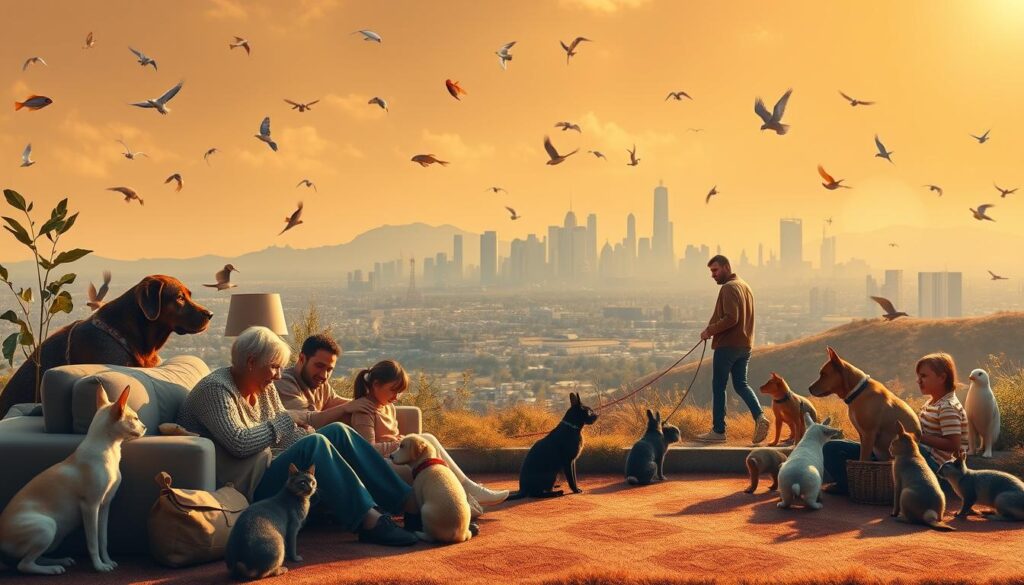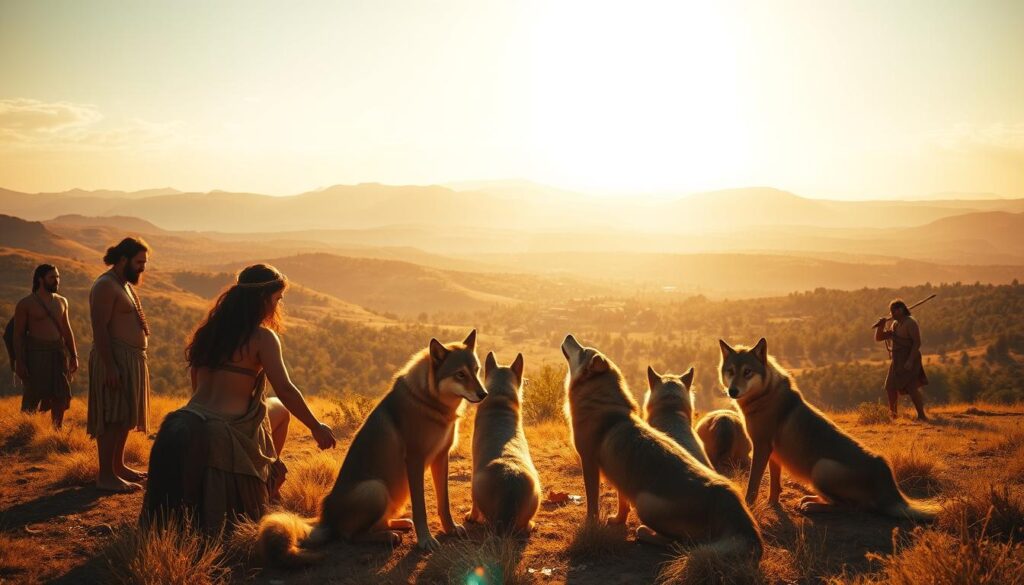Humans and animals have been connected for thousands of years. The history of pet domestication began long ago. Early signs show wolves and wildcats joining human families.
These relationships started from survival needs but grew into deeper bonds.
Table of Contents
ToggleKey Takeaways
- Pet domestication history shows animals were first kept for hunting or work.
- Archaeology reveals early domestication signs through ancient bones and tools.
- Cultural practices varied, shaping which animals became common pets.
- Domestication changed how humans viewed and treated animals over time.
- Pet domestication history links human progress with animal companionship.
Ancient Beginnings and Early Domestication
Looking into the past, we find clues about ancient pet keeping. The first signs of domestication date back thousands of years. Before written records, fossils and ancient art tell us how humans started living with animals.
Early Evidence of Domestication
Scientists look at remains to find proof. For instance:
- 9,000-year-old dog bones from Israel suggest companionship.
- Cave paintings in France show wolves, possibly the start of domesticated dogs.
- Tombs in Egypt feature mummified cats, showing their importance.
Role of Environment in Pet Keeping
The place people lived in influenced which animals became pets. In river valleys, cats were good against rodents. Nomadic groups used dogs for hunting. As ancient pet keeping grew, climate and food sources played a big role.
“Environments didn’t just host early humans—they guided which animals became partners,” says archaeologist Dr. Lena Torres.
These patterns show how needs and surroundings turned wild animals into lifelong friends. Each area’s unique conditions influenced which species humans chose to care for.
Historical Evidence from Archeological Finds
Excavations at ancient sites show how pets influenced early societies. In Egypt, mummified cats were found with their owners. This shows animals were seen as companions and spiritual symbols.
In Turkey’s Çatalhöyük, murals from 9,000 years ago show dogs with humans. This suggests dogs played a big role in daily life. These discoveries highlight the cultural significance of pets as more than tools.
Artifacts like Viking dog collars from Sweden and dog bones in Jordan’s Wadi Faynan show pets were valued across cultures. A 2018 study in Journal of Archaeological Science found dogs ate food provided by humans as far back as 14,000 years ago. This proves humans cared for them intentionally.
| Site | Location | Pet Evidence |
|---|---|---|
| Hierakonpolis, Egypt | Egypt | 3,000-year-old cat burials |
| Çatalhöyük | Turkey | Dog imagery in wall paintings |
| Norse Burial Sites | Sweden | Dogs buried with owners |
These discoveries confirm pets were part of communities, showing values and beliefs. They reveal how animals went from being work animals to beloved companions. This change is rooted in a shared history.
Cultural Significance of Pets Throughout the Ages
Humans and animals have a deep connection that goes beyond just survival. Pets have become a big part of our culture. They are seen as sacred symbols and guardians of spiritual beliefs. Evolutionary pet relationships have shaped stories and practices in many civilizations.
Pets in Myth and Legend
“The cat is the most ancient of the creatures that walk on four legs,” said Herodotus. This shows how much the Egyptians revered cats. They saw cats like Bastet, with a cat’s head, as protectors in myths.
In Norse sagas, wolves were Odin’s companions. This mix of reality and legend shows how animals connected humans to the spiritual world.
In Asian folklore, dogs are seen as symbols of loyalty in the Chinese zodiac. These stories show how animals bridged the gap between humans and the spiritual realm.
Impact on Rituals and Traditions
- Ancient Egyptians mummified pets, treating them as family in death.
- Viking burials often included dogs, believed to guide owners to the afterlife.
- Japanese Shinto rituals honor foxes as messengers of gods.
These practices show how evolutionary pet relationships made everyday life sacred. Pets have become symbols of connection between people and their beliefs. They are part of burial rites and festivals, showing their timeless importance.
when human being start to have pets: Tracing the Roots
Looking into history, we find out when humans first connected with animals. The human-pet bond started long before we had written records. It began with survival and curiosity.
Archaeologists found clues like 12,000-year-old dog remains buried with humans in Jordan. This shows early emotional ties.
Important discoveries include Egyptian cat mummies, Roman dog collars, and Viking rat traps. These show animals were cared for intentionally. Over time, animals went from being wild to being cherished companions.
- Oldest known domesticated dog remains: 12,000 BCE
- Egyptian cat burials: 3,000 BCE
- Roman pet collars with engraved names
Early societies used pets for survival, but they also mourned their losses. This shows pets were valued for both utility and affection. Today, pets are a symbol of trust and companionship in the human-pet bond.
The Role of Pets in Ancient Societies
In ancient times, pets were more than just friends. They were workers, protectors, and symbols of harmony with nature. These animals played key roles in human communities, evolving from survival tools to cherished companions.
Pet Relationships in Daily Life
Early societies depended on pets for both practical tasks and emotional support. Dogs helped with hunting, while cats kept pests away from food. Their presence showed a shift from wild to trusted allies in homes.
- Dogs: Guarded settlements and aided in hunting.
- Cats: Managed rodent populations in agricultural areas.
- Goats and sheep: Provided milk and wool, blurring lines between livestock and companions.
Animal Sanctuaries and Temples
Some animals were revered in sacred spaces. Temples and shrines honored creatures tied to gods, merging spiritual beliefs with domestic animal origins.
| Civilization | Sacred Animal | Significance |
|---|---|---|
| Egypt | Cats | Linked to the goddess Bastet; temples like Bubastis housed feline statues. |
| Greece | Dogs | Associated with Artemis; temple dogs symbolized loyalty in rituals. |
| Mesopotamia | Bulls | Represented strength in myths, depicted in temple carvings. |
These sites reinforced societal values, showing how pets transitioned from tools to cultural icons. Their legacy echoes in modern reverence for animals.
Evolution of the Human-Pet Relationship

Over time, pets became more than just tools. They became part of our families, as seen in art and literature around the world.
From Utility to Companionship
In the past, pets were seen as workers. Art and literature pets from old times often showed dogs herding or cats hunting. By the Renaissance, pets were in portraits, showing wealth and love.
Writers like Mark Twain started to see pets as more than workers. They wrote about pets’ unique personalities. This changed how we view pets today.
Changing Dynamics Over Time
Here are some key changes:
- Pre-Industrial Era: Pets helped with farming and hunting.
- 18th Century: Pets were shown in stories and art as loyal friends.
- Modern Times: Now, pets inspire memes, books, and social media.
These changes highlight how pets went from tools to family members. Their stories are in every era’s art and literature. They show our growing love and understanding of pets.
Influence of Pets on Art and Literature
Pets have long been a source of inspiration for artists and writers. In ancient Egypt, cats were seen as sacred and were often depicted in tomb paintings. During the Middle Ages, dogs were used in manuscripts to symbolize loyalty. Famous artists like Gustav Klimt and writers such as Emily Brontë included pets in their works, highlighting the deep connections between humans and animals.
- Egyptian cats guarded tombs in art, blending myth and reverence.
- Victorian poets wrote odes to dogs, celebrating companionship.
- Modern films and books still explore pet-human relationships, like Marley & Me.
“A dog is the only thing on earth that loves you more than he loves food.” — Russell
The science of domestication played a big role in these stories. As animals became more tame, their roles in stories changed. They went from being symbols of power to being seen as emotional companions. Medieval bestiaries mixed fact and myth, while Renaissance art showed the domesticated side of animals. Today, books like Black Beauty or Watership Down use animals to explore deeper themes.
Pets have been a universal theme in art and literature, from cave paintings to social media memes. Their journey through the science of domestication shows the deep bond between humans and animals. This bond is reflected in every brushstroke and verse.
The Science Behind Pet Domestication
Scientists study how wild animals became pets. They look at genetics and environment. This research helps us understand today’s pets.
Genetic Adaptations
| Animal | Key Genetic Changes |
|---|---|
| Dogs | AMY2B gene boosted starch digestion, aiding survival near farming communities. |
| Cats | Genes linked to tameness, like those affecting social behavior, became more common. |
Environmental Influences
- Early humans’ shift to farming created stable food sources, attracting animals.
- Warmer climates or fertile lands made domestication easier, shaping where pets thrived.
These factors still shape modern pet trends. Dogs digest carbs better than wolves, thanks to their ancient diets. Cats are calm around people because of genes refined over time. The science shows how past choices influence today’s pets.
Modern Perspectives on Age-Old Bonds

Pets today are more than just helpers. They are cherished companions. Global pet ownership shows this change, with pets being seen as family members everywhere. Modern care for pets, from special diets to designer toys, mirrors human lifestyle trends.
“Pets fill emotional gaps in fast-paced lives.”
Pets in Contemporary Society
In the U.S., 68% of homes have pets, according to the American Pet Products Association. Companies like Petco and Chewy offer a range of services, from grooming to vet care. Social media is filled with pet influencers, showing their big impact.
Changing Households and Lifestyles
Urban living and smaller families are changing how we see pets. Key trends include:
- City dwellers adopting compact breeds
- Rising demand for pet-friendly housing
- Remote work routines blending with pet schedules
Global pet ownership data shows a 14% increase in single-person households with pets since 2010. Apps for pet tracking and telehealth services now meet ancient bonds with today’s digital needs.
How Pets Shaped Human Social Interactions
Through pet domestication history, animals became bridges between people. Early humans worked together to care for pets, forming strong bonds. Dogs helped herd livestock, and cats guarded grain stores, requiring teamwork.
This teamwork built trust within groups. Pets in ancient villages showed cooperation and trust. In many cultures, owning rare animals showed social status.
- Pets in ancient villages signaled cooperation and trust.
- Ownership of rare animals marked social rank in many cultures.
- Modern pet-related activities build communities online and offline.
| Time Period | Key Social Role |
|---|---|
| Stone Age | Shared hunting roles fostered group identity |
| Medieval Trade Routes | Cats controlled pests, aiding merchant networks |
| 21st Century | Pet influencers and adoption drives connect global communities |
Pets also influenced language and customs. Phrases like “raining cats and dogs” show our deep cultural ties. Today, pet cafés and online forums keep these bonds alive. The pet domestication history shows pets were more than just friends—they helped humans connect.
Global Trends in Pet Ownership Through Time
Pets have been part of human lives for thousands of years. From ancient times to today, how we see and care for pets varies by region. This section looks at how culture and geography have shaped pet traditions over time.
Regional Variations in Pet Keeping
In ancient Egypt, cats were sacred, seen as symbols of gods. Vikings used dogs for hunting and protection. These examples show how ancient pet keeping met local needs and beliefs.
- Japan: Foxes and birds are lucky symbols in some areas.
- Mesoamerica: Dogs were used for work and as companions.
- Scandinavia: Dogs were bred for herding and survival.
“Cultural values often dictated which animals were valued as companions,” noted archaeologist Dr. Elena Marquez in a 2022 study.
Modern Data and Statistics
Today, over 67% of U.S. homes have pets, according to the APPA. Here are some modern trends:
- Urban areas prefer smaller pets like cats and birds.
- Rural areas still value working animals like livestock guardians.
- Global pet spending reached $173B in 2023, with Asia growing fastest.
These changes show how ancient pet keeping traditions mix with today’s lifestyles. Pets are still important to human culture all over the world.
Conclusion
Humans and pets have been connected for thousands of years. This bond is shaped by culture, environment, and mutual need. The cultural significance of pets is seen in ancient rituals, art, and daily life.
These animals were more than just workers—they were partners. From Egyptian cats seen as gods to modern dogs in our homes, their roles have changed. Yet, their impact remains strong.
Today, over 68% of U.S. homes have pets, blending old traditions with new lifestyles. This shows how pets have shaped us as much as we have shaped them. Their presence in myths, science, and modern stats like rising global pet spending ($100 billion annually in the U.S.) highlight their value.
Understanding this history reveals how pets mirror our values. They have moved from survival tools to cherished companions. The cultural significance of pets isn’t static. It grows with each era, reflecting human progress and emotion.
Exploring this bond offers clues about our past and hints at future connections. Whether gazing at a cat’s eyes or reading ancient carvings, we’re part of a story. Pets are storytellers of shared history.
FAQ
When did humans first start keeping pets?
Humans started keeping pets around 15,000 years ago. This was when wolves were first domesticated into dogs. It began the special bond we share with animals today.
What role did environment play in the domestication of pets?
The environment played a big role in domesticating animals. Things like resources and climate helped decide which animals became pets. For example, farmers had different pets than nomads.
How have pets influenced cultures throughout history?
Pets have been important in many cultures. They’ve been in myths, legends, and rituals. For example, ancient Egyptians loved cats, seeing them as symbols of protection.
What evidence do we have of pets in ancient societies?
We have lots of evidence from ancient times. Things like pet graves show how animals were companions. These finds show pets were important long before we think.
How has the human-animal relationship evolved?
Our relationship with animals has changed a lot. We used to see them as tools, but now they’re family. This change shows how our values and lives have changed.
What are some modern trends in pet ownership?
Today, people want pets for companionship and support. More homes see pets as family. We also see more places welcoming pets and products for their health.
Can pets positively impact social interactions?
Yes! Pets help people meet and connect. They can make friends and even improve social standing. They’re great for building community.
How do pets influence art and literature?
Pets have inspired many artists and writers. They’ve been subjects in art and stories celebrating our bond with them. Their influence is big in creative works.
Why is understanding pet domestication important?
Knowing about pet domestication helps us value our bond with animals. It shows our shared history and the good we get from it.
What are some genetic adaptations observed in domesticated pets?
Pets have changed a lot genetically. They’ve become better at being with humans. These changes show amazing evolution.
What are some common pets in different cultures?
Pets vary by culture. Dogs and cats are loved everywhere, but other animals are special in certain places. These choices show what cultures value.

